Nikon updated its 600mm super-telephoto lens in July of 2015, replacing its “G” version with a completely brand new design and optical formula. The Nikkor 600mm f/4E FL ED VR was released with the best optical technology Nikon had at the time, including a faster autofocus motor, a magnesium alloy construction, and two fluorite elements for significant weight reduction. In fact, compared to its predecessor, Nikon was able to reduce the weight of the lens by a whopping 1250 grams (over 3 pounds), while making the lens sharper and more responsive. In this review, we will take a look at this magnificent piece of glass in more detail and compare it to other Nikon super-telephoto lenses.
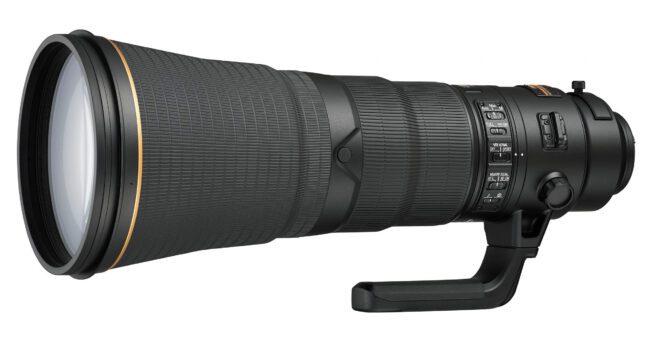
Nikon’s super-telephoto lenses have always been known for their amazing optical and autofocus performance. While many sports and wildlife photographers absolutely loved the Nikon 600mm f/4G ED VR, it was never considered to be a hand-holdable lens, thanks to its 5 kg weight and a very front-heavy design. So its use was limited to tripod use, which was not ideal in many situations (especially when wildlife was on the move). With Canon updating its 600mm lens with fluorite and magnesium/titanium construction, which resulted in significant weight savings, many Nikon shooters waited patiently for Nikon’s turn to update its line-up. The 600mm f/4E FL ED VR finally arrived together with its 500mm sibling, and these were the lenses many Nikon fans had been waiting for.
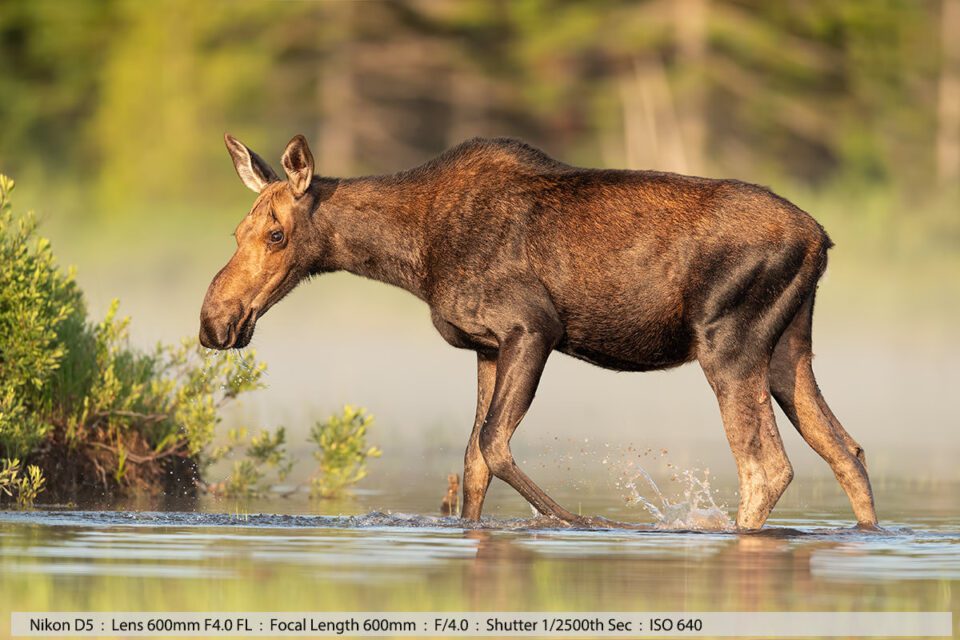
NIKON D5 @ 600mm, ISO 640, 1/2500, f/4.0
Nikon 600mm f/4E FL ED VR Overview
The Nikon 600mm f/4E FL ED VR is primarily aimed at professional sports and wildlife photographers who need maximum reach while maintaining excellent low-light performance (both in terms of maximum aperture and autofocus performance), high build quality, and extreme levels of sharpness. Although Nikon provides a number of different pro-grade super-telephoto prime and zoom options to choose from, the 600mm f/4 lens has always been a popular choice, thanks to its versatility in the field. Many consider 600mm primes to be optimal for photographing distant subjects without disturbing them. For this reason, this focal length is especially popular among wildlife photographers.
As I have already pointed out, Nikon incorporated its best technologies at the time the lens was released. The Nikon 600mm f/4E FL ED VR has a complex optical formula comprising of a total of 16 elements in 12 groups, 2 of which are fluorite elements and 4 of which are extra-low dispersion elements. The fluorite elements replaced the two large ED elements that were previously located on the front part of the lens, and were spaced out in order to distribute the weight of the lens. Take a look at the differences in lens construction between the two:

This made the new 600mm f/4E FL ED VR much less front-heavy compared to its predecessor. As I explain further down in the Lens Handling section, this makes a huge difference in the way the lens handles in the field, finally making it possible to hand-hold a Nikon 600mm f/4 lens!
In addition, the Nikon 600mm f/4E FL ED VR features a much better vibration reduction system capable of compensating up to 4 stops (compared to 2.5 stops on the 600mm f/4G ED VR), which makes it even easier to track and photograph subjects hand-held.
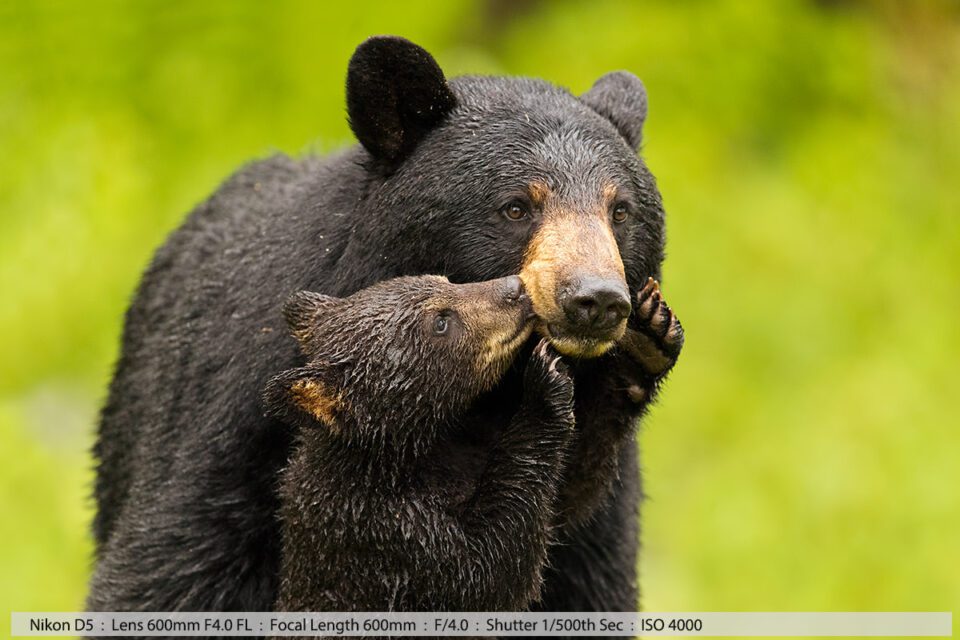
NIKON D5 @ 600mm, ISO 4000, 1/500, f/4.0
Nikon swapped out the mechanical aperture with an electromagnetic diaphragm, which allows the lens to stop down to the chosen aperture precisely every time an image is captured. And when it comes to autofocus, Nikon also improved the SWM autofocus motor on the lens, providing faster and more accurate subject tracking.
Similar to its predecessor, the lens is coated with both Nano and Super Integrated Coat technologies. On top of that, the front element of the lens features fluorine coating, which helps repel dust, dirt, and moisture build-up.

NIKON 600mm f/4E FL ED VR @ f/4.5
At the time of the release, Nikon held the advantage over the Canon 600mm f/4L IS II USM, which was 110 grams heavier in comparison. However, Canon released its third iteration of the lens in 2018, the 600mm f/4L IS III USM, which Canon engineers were able to reduce to just 3050 grams – a remarkable achievement, so Nikon once again has some catching up to do to be able to match Canon’s top-of-the-line offering.
Nikon 600mm f/4E FL ED VR Specifications
- Mount Type: Nikon F-Bayonet
- Focal Length: 600mm
- Maximum Aperture: f/4
- Minimum Aperture f/22
- Maximum Angle of View (DX-format): 2°40′
- Maximum Angle of View: (FX-format) 4°10′
- Maximum Reproduction Ratio: 0.14x
- Lens Elements / Groups: 16 / 12
- VR (Vibration Reduction) Image Stabilization: Yes, Up to 4 Stops
- Diaphragm Blades: 9 (Rounded)
- Diaphragm Type: Electronic
- Fluorite Elements: 2
- ED Glass Elements: 4
- Nano Crystal Coat: Yes
- Super Integrated Coating: Yes
- Autofocus: AF-S (Silent Wave Motor)
- Internal Focusing: Yes
- Minimum Focus Distance: 14.4 ft. (4.4m)
- Filter Size: 40.5mm
- Accepts Filter Type: Slip-in
- Compatible with Nikon AF-S Teleconverters: Yes
- Dimensions: 166 x 432mm
- Weight: 3810g
Detailed specifications for the lens, along with other useful data can be found on the Nikon NIKKOR 600mm f/4E FL ED VR page of our lens database.
Compared to Nikon 600mm f/4G ED VR
Aside from the massive weight differences between the 600mm f/4E FL ED VR and its predecessor, there are a few other changes worth talking about. First of all, the lenses are shaped differently – the new 600mm f/4E has a more evenly-shaped front, and it is a tad shorter in comparison. Take a look at the two (Left: Nikon 600mm f/4E FL ED VR, Right: Nikon 600mm f/4G ED VR):
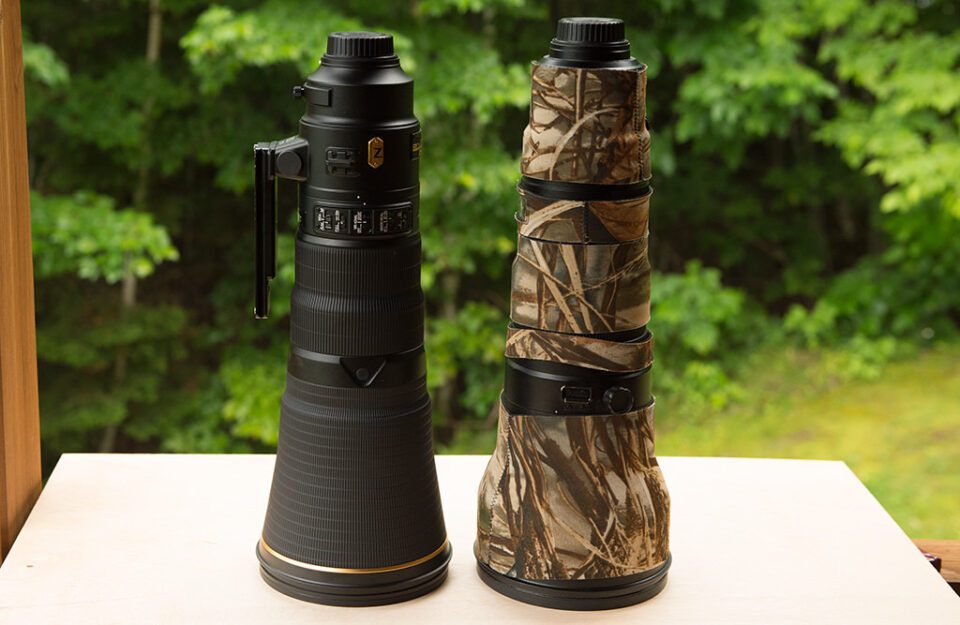
Photo Courtesy of Robert Andersen
The front element diameter is pretty much identical – the new 600mm f/4E hood fits on the old 600mm f/4G and if you put the two lenses end to end, there is no difference in the front diameter at all.
Second, the new Nikon 600mm f/4E FL ED VR now has a one-piece hood instead of the old one being two separate pieces that lock together:
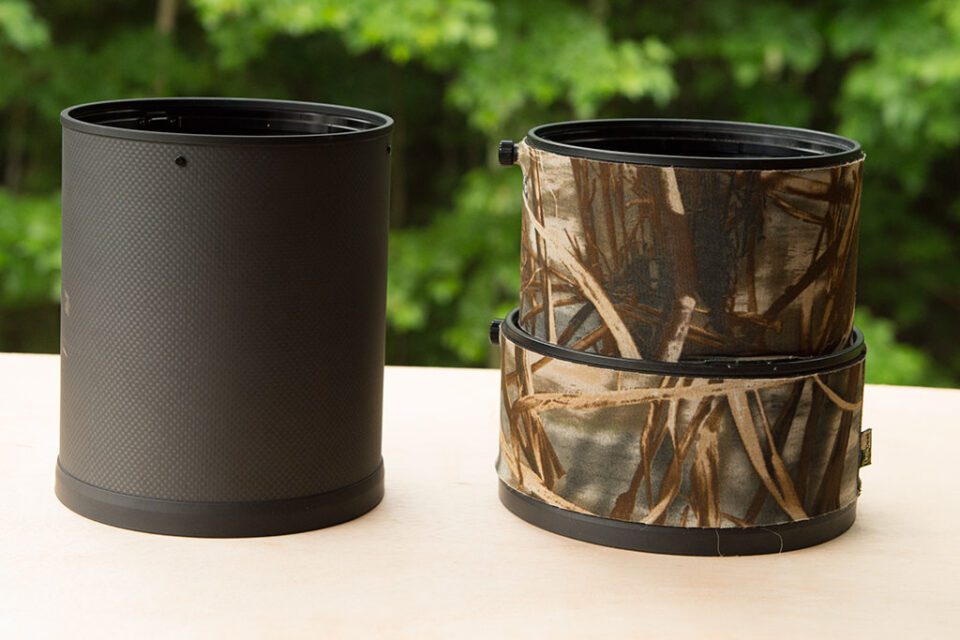
Photo Courtesy of Robert Andersen
Gone is the old VR ring – the 600mm f/4E now has a switch on the side of the lens instead. This is a great improvement to handling as you can now switch VR mode operation without having to look down on the lens to see what position VR is on, or worrying about potentially breaking the mechanical ring. VR now offers an additional SPORT mode, which basically allows the lens to recognize panning motion in order to be able to properly stabilize it without adding camera shake.
What about sharpness differences? While I provide all this detail in the next pages of the review (where I will compare MTF performance side-by-side), take a look at the Nikon-provided MTF charts:
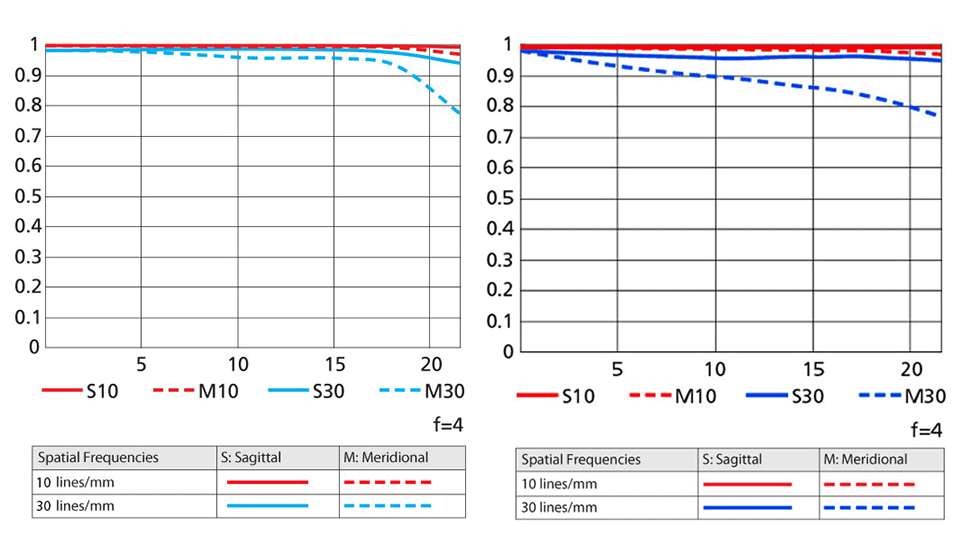
As you can see, while both lenses have remarkably straight MTF curves, the new 600mm f/4E FL ED VR is supposed to be sharper than its predecesor. Pay attention to the second blue line, which has slightly moved up and straightened – an indication of better sharpness across the frame. See my guide on how to read MTF charts if you having a hard time understanding how to read these charts. This is expected since the new 600mm f/4E was specifically designed to yield very high levels of sharpness on modern high-resolution sensors.

NIKON 600mm f/4E FL ED VR @ f/5.6
Build Quality and Handling
Just like with all Nikon exotic super-telephoto lenses, the build quality of the 600mm f/4E FL ED VR is top-notch. Although Nikon shifted to the more lightweight magnesium-alloy construction, the lens is as tough as its all-metal predecessor. Expect the lens to last for many years, especially if you take good care of it. It goes without saying that the Nikon 600mm f/4E FL ED VR is a rugged professional lens designed to withstand physical abuse in all kinds of environments and tough weather conditions. Nikon specifically engineered its super-telephoto lenses to be used and abused in the field, putting extra effort in properly sealing such lenses to withstand and repel dust and moisture.
I love the feel of Nikon’s super telephotos in hands, and the 600mm f/4E is not an exception. It feels like a lens that engineers spent many years designing and refining – from the way it handles to the way it performs in the field. As I have already pointed out, the shift of the weight from the front to the center of the lens makes a huge difference in the way it balances in hands and when attached to a camera. Here are some notes on hand-holding from Robert Andersen:
I used to hand-hold the old 600mm f/4G lens a lot, it was heavy, I could only hand-hold it for short bursts of time. I had to time my shooting, knowing I could only hold it for so long and then have a short pause before re-lifting it again. The new lens really is much lighter and feels much lighter than the official weight difference of 1.2 kg. The main weight of the lens is no longer at the front, the old 600mm was so front heavy, this new lens is beautifully balanced and is a dream to hand-hold compared to the old one.
The weight matters, the 1.2 kg difference is a huge difference. It is not just the weight, it’s where the weight is, the balance of the lens. This new lens is so much more hand-holdable than the old version. At some point, you need the 600mm reach and a gimbal is not possible – this lens opens up hand-holding to a whole new level. The old 600mm f/4G was getting heavier with my age (and I hand-hold a lot), so this new 600mm is going to add many more years of 600mm shooting for me. I can certainly hold it for much longer and much steadier when compared to my previous 600mm f/4G.
Most of the shots in this review were captured hand-held – a huge indication of this lens being much more practical in the field compared to its predecessor.

NIKON D4S @ 600mm, ISO 3200, 1/320, f/4.5
Once you attach a teleconverter on the lens, hand-holding can get a bit tough due to dealing with much longer focal lengths. As you may already know, the longer the focal length and the narrower the effective field of view, the tougher it is to hand-hold a lens to get sharp results – even slight motion might result in blurry photos. This is where image stabilization/vibration reduction (VR) kicks in. VR makes it much easier to hand-hold lenses, particularly for framing shots. By compensating movements of your hands, VR turns “jumpy” action into much smoother movements, allowing your eyes to see subjects better. Nikon updated the vibration reduction system from 2.5 stops to 4 stops of compensation, which is a big difference that you will easily notice when shooting with both lenses. The most important benefit of VR, however, is not how it helps you stabilize the shot for framing, but how it can actually help counter the movements in order to yield sharper images. Additional notes on VR and its effectiveness are provided further down in this review.
For prolonged use of the lens in the field, I would still recommend mounting the 600mm f/4E on a tripod, particularly when set to shoot from a set area – whether shooting from a spot in a football field, or an observation area in a wildlife hotspot. Ideally, you would want to use something like a Wimberley WH-200 gimbal head mounted on a sturdy tripod. Once you get the lens mounted and balanced on a gimbal head, turning it left/right or up/down is very easy and intuitive.
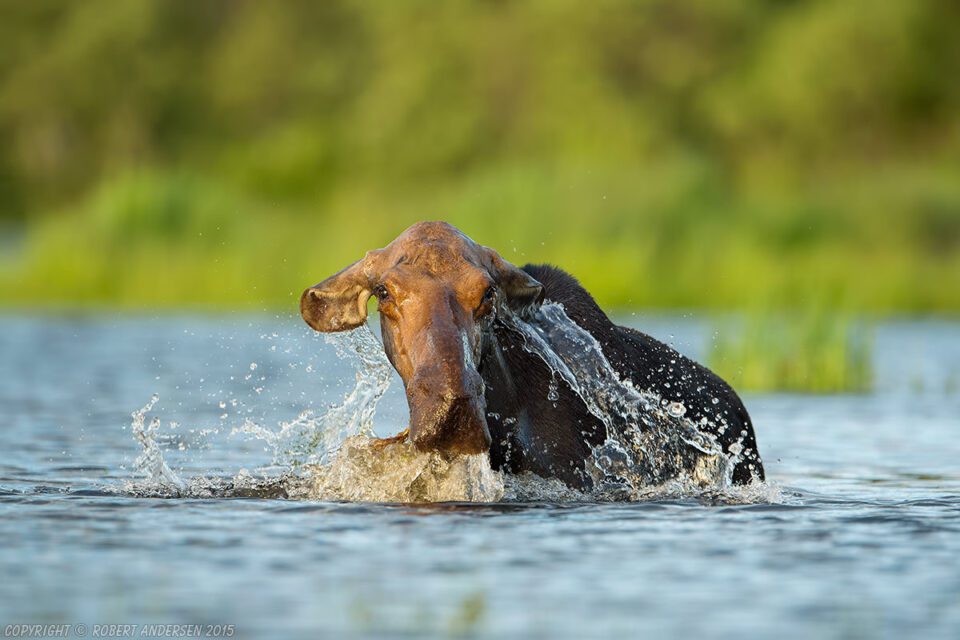
NIKON D4S @ 600mm, ISO 1100, 1/640, f/5.0
Don’t forget to replace the provided foot with an Arca-Swiss version from RRS or Kirk. It still baffles me why Nikon, Canon and other manufacturers still provide useless tripod feet on these high-end lenses. Arca-Swiss has become a standard in the industry and it makes no sense to continue reusing these ancient tripod feet that cannot be properly mounted on any tripod. I cannot imagine fiddling with flimsy tripod adapters just to be able to mount these lenses, and I am sure manufacturers are well aware of this problem. The last thing you want to do is mount a $12K lens on a $100 tripod setup. While the lens is well protected against occasional bumps, it might not survive a drop from a tripod, so keep this mind and invest in a good and stable tripod system.
And if you want to really protect your lens against potential scratches, then I would recommend getting a LensCoat Lens Cover for it. I have previously used LensCoat on a number of different lenses, and it certainly does a very good job at not only protecting the lens but also in keeping my hands warm when shooting in colder temperatures.
The lens collar on the 600mm f/4E FL ED VR is much easier to rotate than on the 600mm f/4G ED VR, which is a nice change. The collar on previous-generation lenses has quite a lot of friction and although it rotates smoothly, it seems unnecessarily tight. The collar on the 600mm f/4E FL ED VR is a definite improvement, as noticed by our team that uses this lens.

NIKON D4S @ 600mm, ISO 200, 1/1250, f/5.0
The focus ring is smooth and easy to operate. When you move the focus ring and reach the focus limit, the ring continues rotation with little resistance in either direction. Overring autofocus is a breeze, although you won’t find yourself doing that a lot, considering how good the autofocus performance of the lens is, even in low-light conditions (see autofocus section below).
All switches on the side of the lens are easy to access and use. Personally, aside from occasionally switching the focus limiter and the focus mode, I rarely touch other controls. But it certainly helps to know what each switch does so that you can easily figure things out when shooting in the field.
The drop-in filter works very similarly on all other Nikon super-telephoto lenses – rotate the screw to unlock the filter holder, push it out, then screw-on a 40.5mm filter. Personally, aside from the glass filter that is provided by Nikon, I never used any other filter on any of Nikon’s super-telephoto lenses, and I don’t know a single person who does.

NIKON D5 @ 600mm, ISO 2200, 1/640, f/7.1
Autofocus Speed and Accuracy
The updated Silent Wave Motor (SWM) on the Nikon 600mm f/4E FL ED VR, along with other improvements (such as updated VR) make a huge difference in the way autofocus is engaged and how accurate it is. Autofocus is incredibly fast – Nikon only puts its best high-speed motors in such lenses, so AF is pushed to its limits. It is truly instantaneous – point the lens at a new spot and half-press, and the focus changes immediately. Thanks to the new VR system, it is now much easier to track moving subjects and avoid erratic shifts in framing. In such situations, switch VR to Sport mode, and the lens will automatically take care of it.

NIKON 600mm f/4E FL ED VR @ f/4.5
Another thing I noticed is that the new 600mm f/4E FL ED VR has much better tripod detection compared to its predecessor. You no longer have to worry about turning VR off when shooting from a tripod to avoid camera shake which is another time-saver, even when using teleconverters.
Autofocusing accuracy is superb, even in low-light environments. This is especially true if you use a modern high-end DSLR with superb low-light AF sensitivity ranges. For this review, we used a combination of different camera bodies such as Nikon D500, D850, D4S, and D5 – they all performed amazingly well with the Nikon 600mm f/4E FL ED VR.